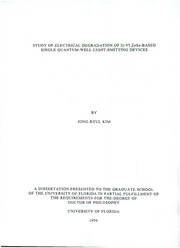
Study of electrical degradation of II-VI ZnSe-based single quantum-well light-emitting devices PDF
Preview Study of electrical degradation of II-VI ZnSe-based single quantum-well light-emitting devices
STUDYOFELECTRICALDEGRADATIONOFII-VIZnSe-BASED SINGLEQUANTUM-WELLLIGHT-EMITTINGDEVICES BY JONGRYULKIM ADISSERTATIONPRESENTEDTOTHEGRADUATESCHOOL OFTHEUNIVERSITYOFFLORIDAINPARTIALFULFILLMENTOF THEREQUIREMENTSFORTHEDEGREEOF DOCTOROFPHILOSOPHY UNIVERSITYOFFLORIDA 1996 Tomyparentsinheaven ACKNOWLEDGMENTS I would like to express my sincere appreciation to my advisor. Dr. Kevin S. Jones, forhis guidance, support, and encouragement. Thanks are also due to my doctoral committee members. Dr. Paul H. Holloway, Dr. RobertM. Park,Dr. RajivK. SinghandDr. TimothyJ. Anderson, fortheir assistanceandinterestinmywork. This work would not have been possible without the samples provided by 3M company. I am grateful to Dr. Greg M. Haugen for his supportofmywork. I would also like to thank Dr. Peter Zory for helping to fabricate LEDs and providing the electroluminescence microscopy and degradation experiment set-up. His advice and discussion during the experiments have beenamajorcontributionin thiswork. Thanks are due to Dr. Maggie Puga-Lambers for providing SIMS analysis and Dr. Matthias H. Ludwig for collecting low temperature photoluminescencedata. I am indebted to my friends and coworkers fortheir encouragement and friendship throughout my stay in Gainesville. My special appreciation goes to Dr. Viswanath Krishnarmoorthy for his advice and discussion in writingthisdissertation. iii Finally, Ithankmywifeandtwo daughters, Sahrang and Harah, for theirsupport. IV TABLEOFCONTENTS page ACKNOWLEDGMENTS iii ABSTRACT viii CHAPTERS INTRODUCTION 1 1 1.1 MotivationandObjectives 1 1.2 ScopeofthePresentWork 3 1.3 LiteratureReviewontheStudyofDegradationofLasers 3 andLEDs 4 1.3.1 II-VIDegradation 4 1.3.2 III-VDegradation 7 1.3.2.1 Rapiddegradation 7 1.3.2.2 Suppressionofrapiddegradation 11 1.3.2.3 Gradualdegradation 12 1.4 GeneralBackground :ElectricalPumping 13 2 EXPERIMENTSANDCHARACTERIZATIONMETHODS 20 2.1 DeviceStructures 20 2.1.1 ATernary-Based Separate-ConfinementHeterostructure 21 2.1.2 ASimplifiedTernary-BasedHeterostructure 22 2.1.3 AQuaternary-Based Separate-Confinement Heterostructure 22 2.2 ElectricalDegradationofLEDs 23 2.2.1 LEDFabricationforEL 24 2.2.2 ExperimentalSetupforELMicroscope 25 2.3 CharacterizationMethods 26 2.3.1 TransmissionElectronMicroscopy 26 2.3.2 HighresolutionX-rayDiffraction 28 2.3.3 Photoluminescence 31 2.3.4 SecondaryIonMassSpectrometry 31 DEGRADATIONTRENDS 41 V 3.1 GeneralDegradationTrends 42 3.1.1 DegradationDependenceonCurrentDensity 44 3.1.2 DegradationDependenceonPre-existingDefectDensity 45 3.2 Efficiency 46 3.2.1 LEDEfficiencyChangeduetoNonradiative Recombination 46 3.2.2 AnalyticalCalculationofEfficiency 49 3.3 I-VCharacteristics 53 3.4 TemperatureintheActiveRegionduringOperation 54 3.5 Summary 58 4 INTERDIFFUSIONAND STRAINRELAXATIONINTHE QUANTUM-WELL 80 4.1 ThermalExpansionBehavioroftheEpilayers 81 4.1.1 MeasurementandCalculationProcedure 83 4.1.2 ResultsandDiscussion 85 4.2 AtomicInterdiffusionduringOperation 87 4.3 RelaxationofStrainintheQuantum-Well 89 4.3.1 StrainDependenceofBandGap 89 4.3.2 LowTemperaturePLMeasurement 93 4.4 Summary 95 5 DEGRADATIONINDUCEDDEFECTS 109 5.1 Pre-existingDefects 110 5.1.1 MisfitandThreadingDislocations 112 5.1.2 [110]DislocationintheMiddleLayer 113 5.1.3 StackingFaults 115 5.2 DegradationInducedDefects 120 5.2.1 DarkDefectsObserved inELMicroscope 120 5.2.2 TEManalysis 122 5.3 Summary 129 6 DEGRADATIONMECHANISM 158 6.1 PointDefectGeneration 161 6.1.1 DiffusionEnhancementduetoPointDefects 164 6.1.2 PLIntensityDecayatHighTemperaturesduetoPoint Defects 166 6.2 NonradiativeRecombination-EnhancedDiffusion 168 6.3 NonradiativeRecombination-InducedAnnealing 171 6.4 Thermal StabilityoftheQuantum-Well 172 6.5 WhyareDLD’sinthe<100>directions? 175 6.6 PossibilityofMeltingatDefects 177 VI 6.7 DegradationCycle 180 6.8 Summary 183 7. Conclusion 205 REFERENCES 211 BIOGRAPHIC SKETCH 220 vii AbstractofDissertationPresentedtotheGraduateSchool oftheUniversityofFloridainPartialFulfillmentofthe RequirementsfortheDegreeofDoctorofPhilosophy STUDYOFELECTRICALDEGRADATIONOFII-VIZnSe-BASED SINGLEQUANTUM-WELLLIGHT-EMITTINGDEVICES By JongRyulKim May, 1996 Chairperson: Dr.KevinS. Jones MajorDepartment; MaterialsScienceandEngineering II-VI ZnSe-based light-emitting devices(LED) were fabricated from variousstructuresconsistingofZn0.gCd0.2Se singlequantumwells onGaAs substrates. LEDswere degraded by applying apulsed direct-current. The degradationratewasfoundedtodepend onthecurrentdensityandthepre- existingdefectdensity. Thetemperature ofthequantumwell (QW)during operationwasestimatedtobeabout 250°C. Efficiency measurement on the LEDs showed that the nonradiative recombination rate increased with increasing degradation. The thermal expansionbehavior ofthe lattice matched epilayers was investigatedusing HRXRD with an in-situ heating stage. At 250 °C the epilayers expanded intheperpendiculardirectionand thestraininthequantumwellincreased by 15%. In the 50%-degraded LEDs, the strain remained constant, however, after 80% degradation 1/3 ofthe straininthe QW wasrelaxed. viii SIMS andPL studiesdidnot showanymeasurable atomicinterdiffusionof theQWduringoperation. LEDs were degraded by the generation ofdark spot defects(DSD) and dark line defects(DLD) that appear in the active region. DLDs were observed to be aligned in <100> directions. The light output intensity decreased with increasing DSDs and DLDs density. TEM analyses on the 80%- degraded LEDs showed thattwo majortypes ofdegradation-induced extended defects formed during operation. One type appeared to be rows of clusters of point defects and the others were distorted crystalline regions that correspond areas of dense networks of dislocations. The spacing ofthe defects (5 pm) was the same as the DLDs observed in EL microscopy. Some DLDs appeared to nucleate from the grown-in stacking faults. In order to study the possible source ofthese defects, point defect formationduring operationwas studied. Generation ofpoint defectswere observed in the degraded LEDs by measuring PL quenching rate at higher temperatures and diffusion enhancement of Cd from the QW into the barrier layers upon post degradation annealing. Nonradiative recombination-induced point-defect generation at pre-existing defect sites and subsequent nucleation ofextended defects is proposed as the major degradationmechanisminZnSe-basedII-VILEDs. IX CHAPTER1 INTRODUCTION 1.1 MotivationandObjectives The development ofcompact short-wavelength light emitters (lasers and LEDs) is certain to have enormous effects on any technology using visible light. For example, bits of information are read and recorded by semiconductorlaserswhoseoutput is afocused, diffraction-limited spot in mostoftoday’s optical recording systems. Becausethe spacing ofthedots that canberead is directlyproportionalto thewavelengthoflightused, a significant gain can be obtained in recording density as well as in data transfer rates simply by using lasers that operate at shorter wavelengths. The ZnSe based II-VI compound semiconductors have been considered a good candidate for producing such short-wavelength lights due to their direct,widebandgap. The first ZnSe-based diode lasers operating at liquid nitrogen temperature were reported in 1991 after successful p-type doping ofZnSe [1]. In 1993 thefirst demonstration oftheblue-green laser diode at room temperaturewaspresented andtheturn-onvoltage ofthelaserwasaround 20 V. Since then, two important breakthroughswere made, the realization 1
